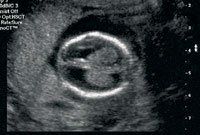Ultrasound Clinics: Diagnosing and managing fetal choroid plexus cysts
Although isolated CPCs rarely have any effect on cerebral function in a chromosomally normal fetus, researchers have recently linked them to trisomy 18. Two experts discuss when to consider invasive prenatal testing.
Between 1% and 3% of all mid-trimester sonograms reveal a choroid plexus cyst (CPC).1 Because they have been linked with aneuploidy, and because they are located in the brain, these cysts usually make expecting parents quite anxious. In this review, we will discuss when these abnormalities are cause for concern and when they can be ignored. In the process, we'll describe the embryology of the choroid plexus, the diagnosis of CPC, and when invasive testing is warranted.

The choroid plexus remains prominent throughout early fetal life and may be visualized with either transvaginal or transabdominal sonography. It's best observed by first obtaining the standard biparietal diameter (BPD) image, and then rotating the transducer rostrally in the same axial plane. This will bring the lateral ventricles into view. The oval-shaped, intensely echogenic area within the lateral ventricles is the choroid plexus. Similarly, in the parasagittal and coronal views, you can see the choroid plexus as you scan through the ventricular spaces. The choroid plexus appears to touch the lateral walls of the lateral ventricle. In pregnancies complicated by ventriculomegaly, however, the choroids will appear to be dangling in the fluid-filled ventricle.

Under normal circumstances, as these cysts mature and brain tissue undergoes organizational changes, they resolve within 24 weeks of gestation. But a small number of cysts persist into the early neonatal period.
Between 1% and 3% of chromosomally normal fetuses will have an isolated CPC in the mid-trimester.1,6,8,12,13 They rarely have any effect on cerebral function. To date, there have been no reports of developmental or neurological deficiencies in chromosomally normal infants with isolated CPC.7
The differential diagnosis of CPC includes arachnoid cysts, hydrocephalus, and neoplasms. Initial hemorrhagic cysts and neoplasms are typically more echogenic and may vary more widely in size. CPCs are typically regular, small echolucent areas that do not distort the brain parenchyma. On rare occasions the cysts may be large enough to mimic hydrocephalus. During hydrocephalus, a generalized enlargement of the lateral ventricles, the ventricles become filled with fluid, and often the choroid plexus will appear to be dangling within this fluid. So in hydrocephalus, the choroid plexus should be visible and distinct from the lateral wall of the ventricle. A CPC should appear as a fluid-filled cavity within the body of the choroid plexus and will have a distinct cyst wall. As we mentioned earlier, cysts should gradually resolve as brain tissue matures and the accumulated fluid is reabsorbed.
